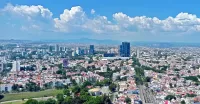Club América, a professional football club based in Mexico City, competes in Liga MX. Founded in 1916 and nicknamed Las Águilas, it has been owned by Televisa since 1959. Club América plays its home games at Estadio Azteca, one of the world's largest stadiums.
October 1916: Team Name and Colors Defined
On 12 October 1916, the team was officially named "América" and its crest and colors were designed. Rafael Garza Gutiérrez chose navy blue trousers and a yellow shirt for the club's kit.
1916: Acceptance into the Mexican Football League
In 1916, Club América proved itself to the Mexican Football League, known as the Primera Fuerza, winning two games and tying the third to gain acceptance.
1916: Club América Founded
In 1916, Club América was founded in Mexico City. The club, nicknamed Las Águilas (The Eagles), now competes in Liga MX.
1916: Florencio Domínguez becomes first club president
In 1916, Florencio Domínguez became the first club president, serving from 1916 to 1920.
1918: Name Change to Club Centro Unión
In 1918, the team changed its name to Club Centro Unión, before reverting to América two years later.
1920: End of Florencio Domínguez's presidency
In 1920, Florencio Domínguez ended his term as club president.
1924: First Primera Fuerza Title
In the 1924–25 season, América won their first Primera Fuerza title, defeating Asturias 1–0 in the deciding match.
1926: First Mexican Club to Play Outside of Mexico
In 1926, Club América became the first Mexican club to play outside of Mexico.
1928: Rafael Garza Gutiérrez designated as head coach
In 1928, Rafael Garza Gutiérrez was designated as the head coach of the Mexico national team.
1930: World Cup consisted of players from Club América
In 1930, most of the national team that participated in the World Cup consisted of players from Club América.
1940: Filiberto Zapata's short term as president
In 1940, Filiberto Zapata had the shortest term in the club's history, serving less than a year.
1942: Establishment of the Liga Mayor
In 1942–43, the first National League was established and it was known as the Liga Mayor (Major League).
1945: Rivalry with Guadalajara Born
During the 1945–1946 season, the rivalry with Guadalajara was born; especially when Guadalajara beat América by 6–4 and 4–2 scorelines.
1946: Rivalry with Guadalajara Born
During the 1945–1946 season, the rivalry with Guadalajara was born; especially when Guadalajara beat América by 6–4 and 4–2 scorelines.
1951: Cantinflas named Honorary President
In 1951, actor and comedian Cantinflas was named Honorary President of Club América.
1951: Finished in 11th place
The 1951–1952 season saw América finish in 11th place out of 12, with a 3-point-advantage over Veracruz.
1952: Finished in 11th place
The 1951–1952 season saw América finish in 11th place out of 12, with a 3-point-advantage over Veracruz.
1954: Campeón de Campeones championship
During the 1954–55 season América won their first Campeón de Campeones championship, defeating Zacatepec 3–2.
1954: Copa México Title
In 1954, América defeated rivals Guadalajara on penalties after a 0–0 draw in the Copa México final, winning their first league cup.
1955: Campeón de Campeones championship
During the 1954–55 season América won their first Campeón de Campeones championship, defeating Zacatepec 3–2.
1956: Club Sold to Jarritos
In 1956, Club América was sold to soft drink manufacturer Jarritos.
July 1959: Acquisition by Emilio Azcárraga Milmo
On 22 July 1959, Emilio Azcárraga Milmo, owner of Telesistema Mexicano, bought América from Isaac Bessudo.
1959: Club América bought by Emilio Azcárraga Milmo
In 1959, Club América was bought by media mogul Emilio Azcárraga Milmo from Issac Bessudo. Since then, the club has been known for being both one of the most popular and the most hated teams in Mexico.
1959: Televisa Ownership
Since 1959, Club América has been owned by mass media company Televisa.
1959: Second Place in the League
The 1959–1960 season saw América reach second place in the league, behind Guadalajara.
1960: Second Place in the League
The 1959–1960 season saw América reach second place in the league, behind Guadalajara.
1961: Guillermo Cañedo de la Bácerna becomes president
In 1961, Guillermo Cañedo de la Bácerna became the club's president, serving until 1981.
July 1962: First Clásico Capitalino
On July 1, 1962, the first match between Club América and Club Universidad Nacional, known as the "Clásico Capitalino", took place, with América hosting UNAM.
April 1964: Copa México Championship
On 21 April 1964, América defeated Monterrey 6–5 in the final match of the Copa México, with Alfonso Portugal scoring five of América's six goals.
May 1965: Mexican "Copa" Championship
On 7 May 1965, América regained the Mexican "Copa" championship after a 4–0 victory over Morelia at the Estadio Olímpico Universitario, with two goals each from Javier Fragoso and Vavá.
May 1966: Inauguration of Estadio Azteca
In May 1966, the Estadio Azteca was inaugurated with a match between América and Torino, ending in a 2–2 tie. The first goal was scored by Arlindo Dos Santos, followed by José Alves. The President of Mexico, Gustavo Díaz Ordaz, made the initial kick, and FIFA President Sir Stanley Rous was present as a witness.
1966: Estadio Azteca Inauguration
In 1966, following its inauguration, Club América shared Estadio Azteca as their home ground with the Mexico national football team. Necaxa and Atlante also used the stadium as their home ground.
1966: Torino functioned as the club's first opponent at the Estadio Azteca
In May 2016, as part of Club América's centenary, a dark red away kit was revealed honouring Italian club Torino, who functioned as the club's first opponent at the Estadio Azteca in the 1966 inaugural match.
1967: Universidad Nacional shares stadium
In 1967, Universidad Nacional started to share Estadio Azteca as their home stadium.
1968: Estadio Azteca hosts the Summer Olympics
In 1968, Estadio Azteca hosted the Summer Olympics.
1969: Universidad Nacional stops sharing stadium
In 1969, Universidad Nacional stopped sharing Estadio Azteca as their home stadium.
1970: Necaxa, Atlético Español share stadium
In 1970, Necaxa and Atlético Español started using the Estadio Azteca as their home stadium.
1971: Second League Title
In 1971, América obtained their second league title after winning the second-leg 2–0 against Toluca at the Estadio Azteca.
1971: Cruz Azul shares stadium
In 1971, Cruz Azul started to share Estadio Azteca as their home stadium.
1972: League Final Victory Against Cruz Azul
For the 1987–88 season, América reached the league final and faced Cruz Azul, which was the first time the two clubs met in the final since 1972. América won the championship by a 5–4 aggregate score.
1975: Estadio Azteca hosts the Pan American Games
In 1975, Estadio Azteca hosted the Pan American Games.
1975: Finished in first place
In the 1975–1976 season, América finished in first place during the season.
1976: Championship Against Universidad de Guadalajara
In 1976, América won the championship after beating Universidad de Guadalajara in the Jalisco Stadium 3–0 and 1–0 at the Estadio Azteca. They also won the Campeón de Campeones title by beating Tigres UANL 2–0.
1977: CONCACAF Champions' Cup Title
In 1978, América also became the first confederation side to earn the "double" in a single year as it won the delayed 1977 CONCACAF Champions' Cup.
1978: First Copa Interamericana Title
In 1978, América won their first Copa Interamericana, defeating Argentine club Boca Juniors 2–1 in a playoff match after extra-time, becoming the first team from Mexico and from the CONCACAF region to win the competition.
1981: End of Guillermo Cañedo de la Bácerna's presidency
In 1981, Guillermo Cañedo de la Bácerna ended his term as club president.
1981: Rebranding and media campaign by Televisa
In 1981, Televisa undertook a rebranding and media campaign for Club América, resulting in the nickname Águilas (Eagles). This included a new kit and color scheme, introduced at a press conference held at the Estadio Azteca.
1982: Club América team colors changed
Around 1982, Club América team colors changed, with the cream color replaced with a more vibrant yellow and blue, along with the introduction of the inverted triangle design on the shirt.
1982: Necaxa, Atlante share stadium
In 1982, Necaxa and Atlante continued to use Estadio Azteca as their home stadium.
1983: Final del Siglo
During the 1983–1984 season, América reached the finals against arch-rivals Guadalajara, resulting in a 5–3 aggregate victory for América. The series has since been dubbed the "Final del Siglo" ("Final of the Century").
1983: Estadio Azteca hosts the FIFA World Youth Championship
In 1983, Estadio Azteca hosted the FIFA World Youth Championship.
1984: Final del Siglo
During the 1983–1984 season, América reached the finals against arch-rivals Guadalajara, resulting in a 5–3 aggregate victory for América. The series has since been dubbed the "Final del Siglo" ("Final of the Century").
1985: League Final Victory Against UNAM
For the 1987–88 season, América defeated UNAM by an aggregate score of 4–2 in the final, in a replay of the 1985 final.
1986: Prode-85 Championship
Due to Mexico hosting the 1986 World Cup, América clinched the top of their group in the Prode-85 and defeated Jaibos Tampico Madero to win the championship with an aggregate score of 5-4.
1987: League Final Victory Against UNAM
For the 1987–88 season, América defeated UNAM by an aggregate score of 4–2 in the final.
1987: Mexican Super Cup and CONCACAF Champions' Cup
In 1987–88, América won the Mexican Super Cup and the 1987 CONCACAF Champions' Cup.
1988: Mexican Super Cup and League Title
During the 1988–89 season, América won the league title and the Mexican Super Cup
1990: CONCACAF Champions' Cup and Copa Interamericana Titles
During the 1990s, América won the CONCACAF Champions' Cup in 1990 and 1992, and the 1990 Copa Interamericana.
1991: Lost to UNAM in the final
During the 1990–1991 season, América dominated its group and reached the playoffs to eliminate Universidad de Guadalajara in the quarter-final round and Guadalajara in the semi-final round, only to reach the final and lose to UNAM.
1992: CONCACAF Champions' Cup Title
During the 1990s, América won the CONCACAF Champions' Cup in 1990 and 1992, and the 1990 Copa Interamericana.
1994: Hiring of Leo Beenhakker
In 1994, club president Emilio Diez Barroso announced the hiring of Dutch manager Leo Beenhakker and signed African players François Omam-Biyik and Kalusha Bwalya, along with Mexican players like Joaquín del Olmo and Raúl Gutiérrez. They reached the semi-finals, losing to Cruz Azul.
1996: Cruz Azul, Atlante share stadium
In 1996, Cruz Azul and Atlante continued to use Estadio Azteca as their home stadium.
1998: Copa Libertadores Tournament
In 1998, América, along with Guadalajara, became the first Mexican club to participate in the Copa Libertadores tournament, being eliminated by Argentine club River Plate.
April 1999: Establishment of La Monumental
In April 1999, La Monumental was established as the first barra brava officially recognized by Club América.
1999: Estadio Azteca hosts the FIFA Confederations Cup
In 1999, Estadio Azteca hosted the FIFA Confederations Cup and welcomed Pope John Paul II.
October 2000: Creation of Disturbio
In October 2000, Disturbio was created as an affiliate group of La Monumental.
August 2001: América wins CONCACAF Giants Cup
In August 2001, Club América defeated D.C. United 2–0 to win the CONCACAF Giants Cup.
2001: Atlante shares stadium
In 2001, Atlante continued to use Estadio Azteca as their home stadium.
2001: Best North American Club
In 2021, América was named by the International Federation of Football History & Statistics as the best North American club of the first decade (2001–2011) of the 21st century.
2002: Manuel Lapuente leads Club América to the league title
In 2002, Manuel Lapuente led Club América to the league title.
2003: Necaxa stops sharing stadium
In 2003, Necaxa stopped using Estadio Azteca as their home stadium.
2004: Atlante shares stadium
In 2004, Atlante continued to use Estadio Azteca as their home stadium.
2005: América wins tenth league title
In 2005, Club América won its tenth league title by defeating Tecos UAG in the Clausura tournament final with a 7–4 aggregate score.
April 2006: América wins CONCACAF Champions' Cup
On April 19, 2006, América won the CONCACAF Champions' Cup by defeating Toluca, qualifying for the FIFA Club World Cup.
2007: América eliminated from playoffs
In 2007 during the Apertura tournament, América was eliminated from the playoffs after being beaten by Morelia.
2007: América ranked tenth in IFFHS's Club World Rankings
In 2007, América was ranked tenth in the IFFHS's Club World Rankings, becoming the first Mexican club to reach the top ten.
2007: Atlante stops sharing stadium
In 2007, Atlante stopped using Estadio Azteca as their home stadium.
2007: América finishes runners-up against Pachuca
In 2007, after qualifying for the playoffs of the Clausura tournament, América played the final against Pachuca, finishing as runners-up.
2008: América's poor performance in the Clausura tournament
In 2008, América had a poor showing in the Clausura tournament, finishing next-to-last in the general standings and failing to qualify for the playoffs for the third-straight tournament.
2008: América wins InterLiga Tournament
In 2008, América won the InterLiga tournament, defeating Cruz Azul, thus assuring qualification to the Copa Libertadores tournament that same year.
2008: América qualifies for 2011 Copa Libertadores
In 2010 for the Apertura tournament, América finished the tournament in first place of Group 2, fourth in the general standings, with 27 points, which led them to automatically qualify for the first time since 2008 for the 2011 Copa Libertadores.
2010: Manuel Lapuente returns as manager for América
In 2010 for the Apertura tournament, Manuel Lapuente returned as manager for América. They finished the tournament in first place of Group 2, fourth in the general standings, with 27 points.
2010: Club América crest modified
In 2010, the Club América crest was modified with the yellow and blue more vibrant and a darker outline and border.
September 2011: Carlos Reinoso sacked as manager
On September 18, 2011, Carlos Reinoso was sacked as manager of América, and Alfredo Tena took over as interim manager.
2011: Commemorative jersey unveiled
During the Apertura 2011 tournament – what was the club's 95th anniversary – a commemorative jersey was unveiled paying homage to the original uniform, as well as an altered crest. The uniform was used during the Súper Clásico match against Guadalajara.
2011: América qualifies for 2011 Copa Libertadores
In 2010 for the Apertura tournament, América finished the tournament in first place of Group 2, fourth in the general standings, with 27 points, which led them to automatically qualify for the first time since 2008 for the 2011 Copa Libertadores.
2011: Estadio Azteca hosts the FIFA U-17 World Cup Final
In 2011, Estadio Azteca hosted the FIFA U-17 World Cup Final.
2011: Best North American Club
In 2021, América was named by the International Federation of Football History & Statistics as the best North American club of the first decade (2001–2011) of the 21st century.
April 2013: Club América Archived
In April 2013, Club América's page was archived.
May 2013: América wins eleventh league title
On May 26, 2013, América won their eleventh league title by defeating Cruz Azul in the Clausura final 4–2 on penalties.
December 2013: América ranked as Mexico's most popular club
In December 2013, a Reforma newspaper survey indicated that América was the most popular club in Mexico, with 25 percent support nationwide and being the most popular in Mexico City.
December 2013: Antonio Mohamed announced as América's new manager
On December 17, 2013, Antonio Mohamed was announced as América's new manager for the Clausura 2014 tournament, replacing Miguel Herrera.
2014: América Ranked Most Popular Mexican Club in Asia
According to a 2014 study conducted by EuroAmericas Sports Marketing, Club América was ranked as the most popular Mexican club in Asia.
2014: América wins record-twelfth league title
On December 14, 2014, América won a record-twelfth league title after defeating Tigres UANL 3–1 on aggregate in the final.
2014: Antonio Mohamed announced as América's new manager
On December 17, 2013, Antonio Mohamed was announced as América's new manager for the Clausura 2014 tournament, replacing Miguel Herrera.
February 2015: América named most popular club in poll
In February 2015, a poll by Consulta Mitofsky named América as the most popular club in Mexico, with 31.1 percent of the population being supporters.
April 2015: América wins CONCACAF Champions League title
In April 2015, Club América won its sixth CONCACAF Champions League title after defeating Montreal Impact in the finals by a 5–3 aggregate score.
April 2016: América Defeats Tigres UANL to Win CONCACAF Champions League
In April 2016, América successfully defended the CONCACAF Champions League title after defeating Tigres UANL 4–1 on aggregate in the finals, and winning a record seventh continental title.
May 2016: Dark red away kit revealed
In May 2016, as part of Club América's centenary, a dark red away kit was revealed honouring Italian club Torino, who functioned as the club's first opponent at the Estadio Azteca in the 1966 inaugural match.
2016: Centenary Celebrations and 'Historic Players' Selection
As part of Club América's centenary celebrations in 2016, a public vote was conducted via the club's website to select 'Historic Players'.
2016: América Ranked Most Supported Team
In 2016, Club América was ranked as the most supported team in the country.
2017: América Ranked Most Supported Team
In 2017, Club América was ranked as the most supported team in the country.
2018: América Falls to Second Most Supported Team
In 2018, Club América fell to the second most supported team in the country.
2018: Cruz Azul shares stadium
In 2018, Cruz Azul started to share Estadio Azteca as their home stadium.
2018: América wins thirteenth league title
In the 2018 Apertura final, América won its record thirteenth league title following a 2–0 aggregate victory over Cruz Azul.
April 2019: América defeats FC Juárez in Copa MX Final
In April 2019, América defeated Ascenso MX side FC Juárez in the final of the Clausura edition of the Copa MX, winning a record sixth title.
2019: América is outright record winner
From 2019 to 2025, América held the distinction of being the outright record winner of its domestic league, cup competition, and confederation.
2019: América Regains Top Spot
In 2019, Club América regained the top spot with 32 percent, doubling the amount of Guadalajara supporters for the first time.
2020: América Ranked Among Most Popular Teams in the U.S.
According to a 2020 survey by Gilt Edge Soccer Marketing, Club América is the ninth most popular team in the U.S., being the only non-European team in the top ten.
2021: América Eliminated by UNAM in 2021 Apertura Quarter-Finals
América led the table during the 2021 Apertura and faced elimination in the same phase again, losing 3–1 on aggregate to UNAM.
2021: Best North American Club
In 2021, América was named by the International Federation of Football History & Statistics as the best North American club of the first decade (2001–2011) of the 21st century.
2022: América manages to qualify consecutively to the semi-finals since the 2022 Clausura onwards
From the 2022 Clausura onwards, América managed to qualify consecutively to the semi-finals, only to face eliminations against Pachuca, Toluca (2022 Apertura), and Guadalajara (2023 Clausura), respectively.
2023: América manages to qualify consecutively to the semi-finals since the 2022 Clausura onwards
From the 2022 Clausura onwards, América managed to qualify consecutively to the semi-finals, only to face eliminations against Pachuca, Toluca (2022 Apertura), and Guadalajara (2023 Clausura), respectively.
2023: Cruz Azul stops sharing stadium
In 2023, Cruz Azul stopped sharing Estadio Azteca as their home stadium.
2023: América defeats Tigres UANL to Win Liga MX
Under new manager André Jardine, América ended the regular phase of the 2023 Apertura first in the standings and defeated Tigres UANL 4–1 on aggregate in the finals to win a record-extending 14th title and end the club's five-year league drought.
2024: América defeats Cruz Azul in Clausura finals
In 2024, América successfully defended the title after defeating Cruz Azul in the Clausura finals, winning back-to-back Liga MX titles for the first time in the club's history since the introduction of the playoff format, and becoming the fourth club to do so under the format. They also became the first team to achieve this feat after having topped the standings of both Apertura and Clausura championships.
2024: Floated on the Mexican Stock Exchange
In 2024, Club América became the first football club to be floated on the Mexican Stock Exchange (Bolsa Mexicana de Valores).
May 2025: Valued at US$770 million
According to Sportico, as of May 2025, Club América is valued at US$770 million, making it one of the most valuable clubs in North America.
June 2025: América is Mexico's most supported and hated team
As of June 2025, América is Mexico's most supported team with 21 percent, and the most hated with 46.2 percent. Its extensive fan base also makes Club América among the most followed teams on social media, ranking third in all of Latin America behind only Brazilian sides Flamengo and Corinthians.
2025: América is outright record winner
From 2019 to 2025, América held the distinction of being the outright record winner of its domestic league, cup competition, and confederation.
2025: Club América fails to qualify for 2025 FIFA Club World Cup
In 2025, Club América would also fail to qualify for 2025 FIFA Club World Cup, losing to LAFC 2-1 in the playoffs. Later they would lose again to Toluca 1-3 in the 2025 Campeón de Campeones.
Mentioned in this timeline
Cruz Azul is a professional football club based in Mexico...

Guadalajara the capital of Jalisco in western Mexico is a...

Football is a family of team sports primarily involving kicking...

FIFA F d ration Internationale de Football Association is the...

Mexico City is the capital and largest city of Mexico...
Mexico officially the United Mexican States is a North American...
Trending

TSLAQ is an international collective of short-sellers skeptics and researchers critical of Tesla and Elon Musk Organizing primarily on social...
MarShawn Lloyd is an American professional football running back currently playing for the Green Bay Packers in the NFL He...

1 month ago Trump Withdraws Nominee for Top IRS Lawyer Amidst Loomer Controversy.
2 months ago Orlovsky urges more Derrick Henry carries; Gronkowski warns AFC Contender faces disaster

16 days ago Yankees and Mets compete for Cody Bellinger; Yankees consider Kyle Tucker.

Alan Jackson is a highly successful American country music singer-songwriter celebrated for his neotraditional country sound He distinguishes himself by...
Popular

Candace Owens is an American conservative political commentator and author...

Ilhan Omar is an American politician currently serving as the...

XXXTentacion born Jahseh Dwayne Ricardo Onfroy was a controversial yet...

Frederick Christ Trump Sr - was an American real estate...

Oprah Winfrey an American talk show host television producer actress...

Charles James Charlie Kirk was a prominent American right-wing political...